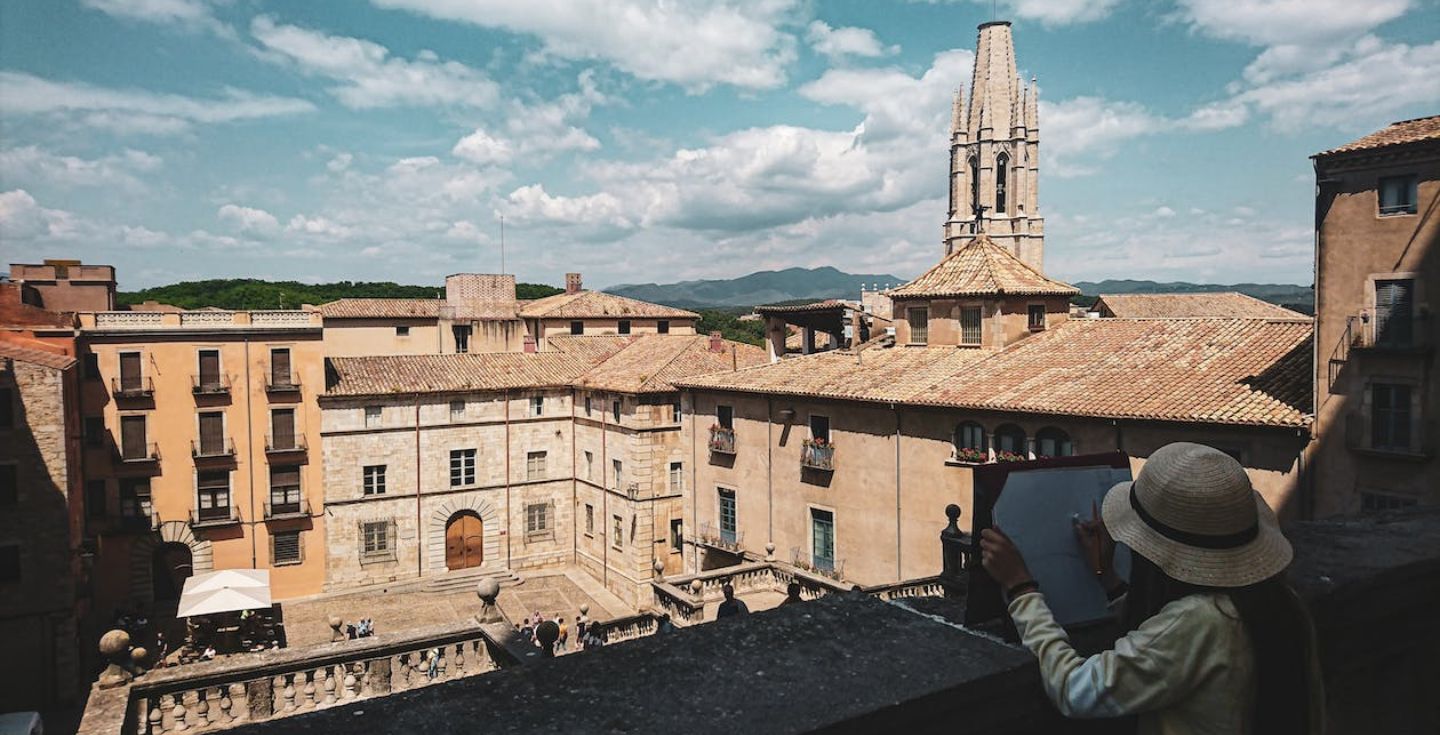Best food in Spain: What to try, how to pair it, and where to find it
From paella and gazpacho to jamón ibérico and tortilla española, explore the best food in Spain—plus drink pairings, tips, and where to try each dish.
If you’re visiting Spain and only know paella or tapas, you’re in for a treat. From sizzling garlic shrimp to thick tomato soups served chilled, the best food in Spain is regional and packed with character. But with so many dishes (and so many bars!), it can be hard to know what to order.
This food travel guide through Spain breaks it all down — one iconic bite at a time. You’ll discover the most popular food in Spain, learn which drink to pair with each dish, and get tips on where to try delicious things like a local.
1. Paella de mariscos, Valencia
Arguably Spain’s most iconic dish, paella de mariscos (seafood paella), comes from Valencia and celebrates the country’s love affair with fresh seafood and olive oil.
Made with saffron-infused rice and loaded with prawns, mussels, clams, and sometimes squid, this staple paella is one of Spain’s most beloved seafood dishes served in most bars and restaurants.
This paella is traditionally cooked in a wide, shallow frying pan over an open flame, giving the rice its signature crispy bottom layer, the socarrat. If there’s one of the food traditions you absolutely have to try in Spain, it’s this.
Drinks pairing: A crisp glass of Albariño or a chilled Verdejo is a recommendation in many restaurants, perfect to balance the richness of the seafood. Or do as the Valencians do and go for a light agua de Valencia (a sparkling cocktail made with cava and orange juice).
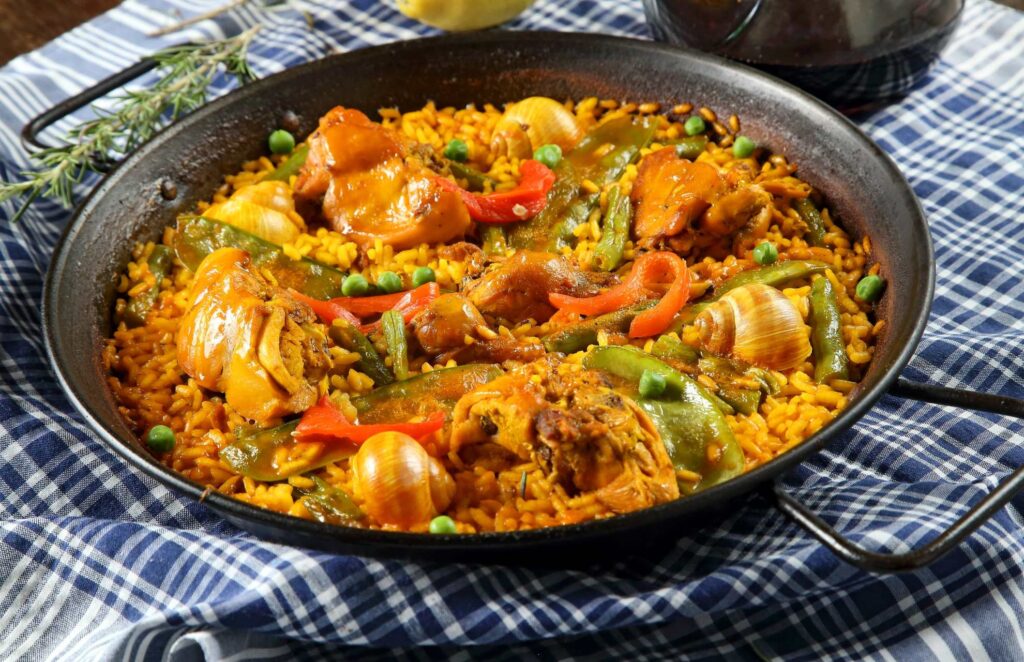
Where to try it:
- La Pepica (Valencia): A beachside institution with a century of paella history.
- Casa Roberto (Valencia): Known for traditional paella Valenciana and its seafood-rich variations.
- El Palmar (Albufera Natural Park): For an authentic paella experience just outside the city, surrounded by rice paddies.
2. Fideuà (Valencia)
A coastal twist on paella, fideuà swaps rice for short noodles and loads up on cuttlefish, monkfish, squid, and other seafood. Cooked in olive oil and seafood broth until just right, it’s finished with a crispy bottom layer called socarrat.
One of the most underrated seafood dishes you can try in Spain, it’s often served with crusty bread and a side of alioli. You’ll find it everywhere, from seaside bars to Michelin-starred restaurants in big cities, putting a modern spin on this Valencian staple.
Drinks pairing: Go for a glass of rosado or a local beer like Turia. Light, bubbly cava also works beautifully with most Spanish food.

Where to try it:
- El Rek (Albufera): Rustic and family-run, known for seafood dishes cooked with heart.
- Casa Salvador (Cullera): A local favorite for traditional fideuà, served right on the beach.
- La Sirena (Gandía): An upscale restaurant offering an elegant, elevated take on the original.
If Italy has seafood pasta, Spain’s fideuà holds its own — less famous, just as fierce in flavor. And if you’re craving more Mediterranean classics, this guide to Italian cuisine is worth bookmarking, too.
3. Patatas bravas (Madrid)
A staple on nearly all tapas menus, patatas bravas are one of the most famous Spanish dishes — and a must-try for anyone curious about what food Spain is known for.
These crispy, golden potatoes are typically served in bite-sized chunks and topped with a generous dollop of spicy sauce — usually a smoky tomato sauce with a hint of paprika, sometimes mayo or aioli.
You’ll find patatas bravas in nearly every tapas bar across the country, but they’re especially iconic in Madrid, where locals swear by their favorite versions. The smoky, slightly acidic, spicy sauce is what sets great patatas bravas apart from the rest.
Drinks pairing: A cold beer is the go-to choice, especially something local like Mahou. If you’re feeling bold, try it with sweet vermouth on ice—a classic Madrid aperitif.
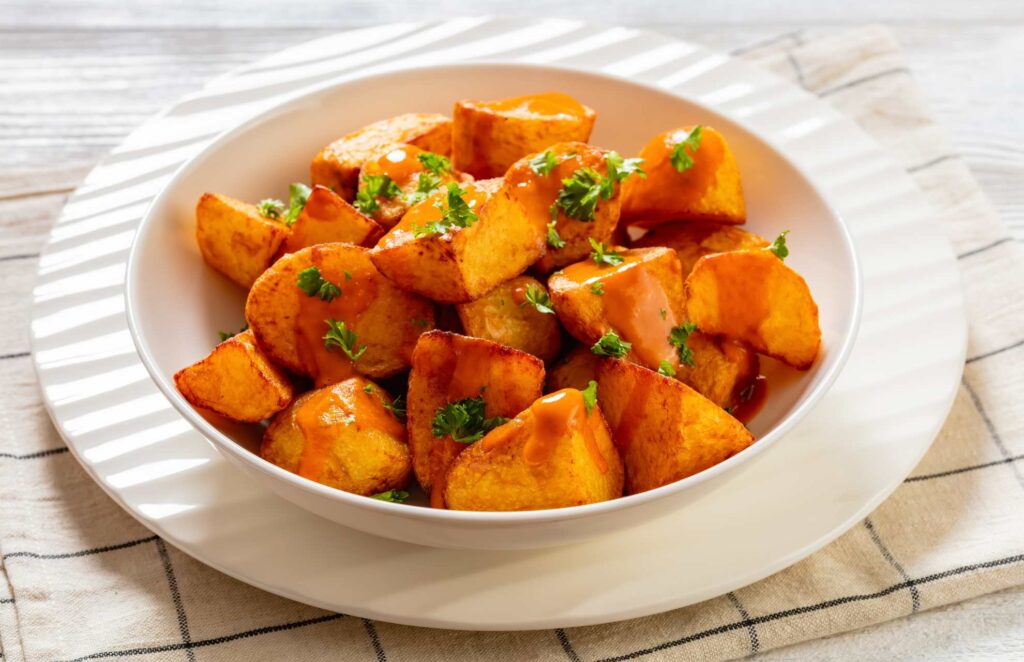
Where to try it:
- Las Bravas (Madrid): This spot claims to have invented the original patatas bravas spicy sauce.
- Docamar (Madrid): Legendary for its massive portions of patatas bravas and cult-favorite sauce.
Juana La Loca (Madrid): A chic twist on the classic patatas bravas, served in a lively modern setting.
4. Tortilla española (Madrid)
Few Spanish dishes spark more debate than tortilla española — and it’s not about whether to eat it, but how. This thick, golden omelet is made with eggs, potatoes, and olive oil, sometimes with onions (a point of national controversy). Served warm or cold, in wedges or on bread, it’s a simple but satisfying staple of traditional food in Spain.
If you’re just looking for comforting food to eat in Spain, this dish is a classic. You’ll find it at everything from tapas bars to family kitchens — and it always hits the spot.
Drinks pairing: A glass of red Rioja or a light beer like Alhambra complements the richness beautifully.

Where to try it:
- Bodega de la Ardosa (Madrid): Historic spot serving one of the city’s most famous tortillas.
- Casa Dani (Madrid): Often hailed as Madrid’s best — fluffy inside, crispy outside.
- Sylkar (Madrid): Known for its juicy, slightly runny version — an onion-lover’s dream.
5. Croquetas (Madrid)
Creamy, crunchy, and deeply comforting, croquetas are bite-sized pieces of fried dough made from a rich bechamel sauce base mixed with ham, cheese, mushrooms, or many other fillings. Rolled in breadcrumbs and deep fried to golden perfection, they’re a staple of tapas culture and one of Spain’s most universally loved bites of good food.
Nothing beats deep fried dough. You’ll find croquetas on menus everywhere — they can be a snack, a side dish, or even a main course. Few fried dough creations feel this indulgent and classic all at once, with the smooth bechamel sauce at the heart of every great croqueta.
Drinks pairing: Pair them with a dry sherry like fino or a chilled glass of white wine. For something casual, you can’t go wrong with a caña (small draft beer).

Where to try it:
- Casa Julio (Madrid): Famous for croquetas in flavors like blue cheese, morcilla, and spinach.
- Santerra (Madrid): Their ham croqueta won Spain’s top prize — no joke.
- Viavélez (Madrid): A cozy spot blending traditional and modern takes on classic tapas.
6. Gambas al ajillo (Andalusia)
Simple yet packed with flavor, gambas al ajillo — garlic shrimp — is a star among tapas in southern Spain. Sizzling in hot olive oil with thinly sliced garlic, dried chili, and a touch of parsley, the shrimp arrive at your table still bubbling in the dish. It’s a must-try for anyone seeking bold, authentic Spanish dishes.
Common in tapas bars across Andalusia and beyond, this dish is perfect for fresh seafood lovers. Served with toasted bread to soak up the oil, it’s one of the most satisfying bites you can try in Spain.
Drinks pairing: A chilled glass of manzanilla sherry or a crisp Albariño makes a natural match.
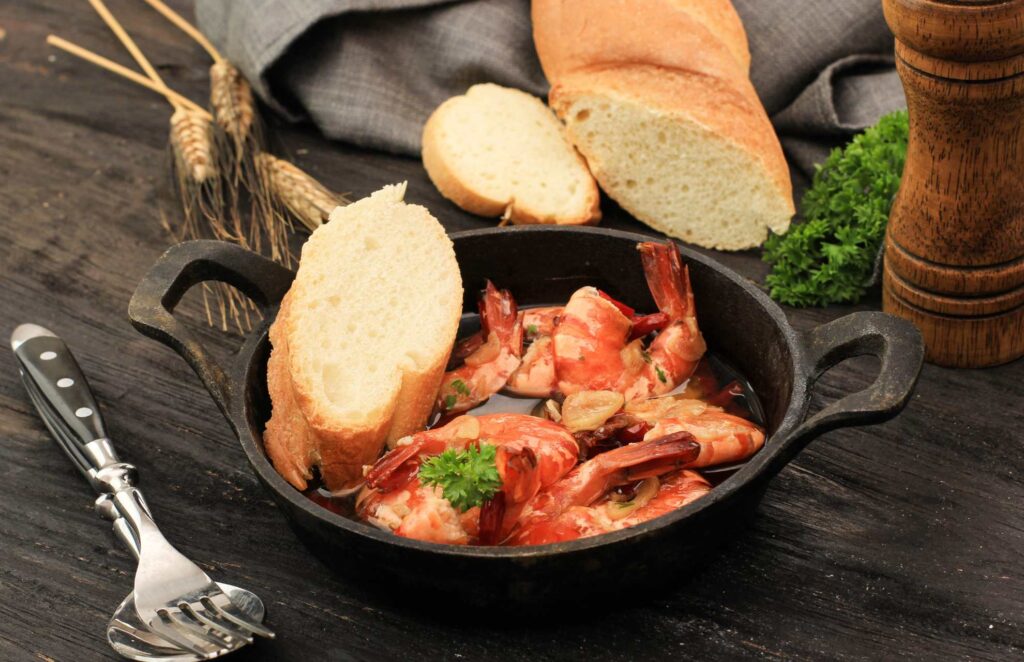
Where to try it:
- La Casa del Abuelo (Madrid): Iconic tapas place for this dish — they’ve been serving it since 1906.
- El Faro de Cádiz (Cádiz): Traditional Andalusian fare with excellent seafood.
- El Pintón (Seville): A stylish spot that keeps this classic food on the menu year-round.
7. Salmorejo (Andalusia)
Often overshadowed by its lighter cousin gazpacho, salmorejo is a thicker, creamier cold soup from southern Spain, made with ripe tomatoes, stale bread, garlic, and a generous pour of extra virgin olive oil. Blended until smooth and velvety, it’s typically topped with chopped hard-boiled egg and jamón serrano, though jamón iberico is sometimes used.
Served chilled, it’s a refreshing yet hearty dish that showcases the essence of Spanish cooking — simple ingredients elevated through technique. If you’re looking to truly dine in Spain like a local, this is one of the most iconic foods to order.
Drinks pairing: Pairs well with a dry white wine or a cold glass of fino sherry. Water with lemon is also a common accompaniment in the summer heat if you want to skip alcoholic drinks.

Where to try it:
- Casa Pepe de la Judería (Córdoba): A classic stop in the heart of the old town.
- Taberna Salmorejo (Seville): Specializes in traditional and modern versions of this dish.
- Bar Santos (Córdoba): Right by the Mezquita, known for massive tortillas and excellent salmorejo.
8. Gazpacho (Andalusia)
Let’s give it the love it deserves — gazpacho is more than just a chilled vegetable blend. This iconic cold soup from southern Spain is made with raw fresh produce like tomatoes, cucumbers, bell peppers, garlic, and onions, blended with extra virgin olive oil and vinegar. Light, tangy, and served ice-cold, it’s Spain’s answer to summer heat.
While often compared to salmorejo, gazpacho is thinner and brighter — more of a drink than a spoonful. It’s one of the first answers you’ll hear when you ask what food is Spain known for, especially in Andalusia.
Drinks pairing: Sparkling water with lemon is a common pairing. For something stronger, try a chilled glass of white vermouth or rebujito (sherry with lemon soda).
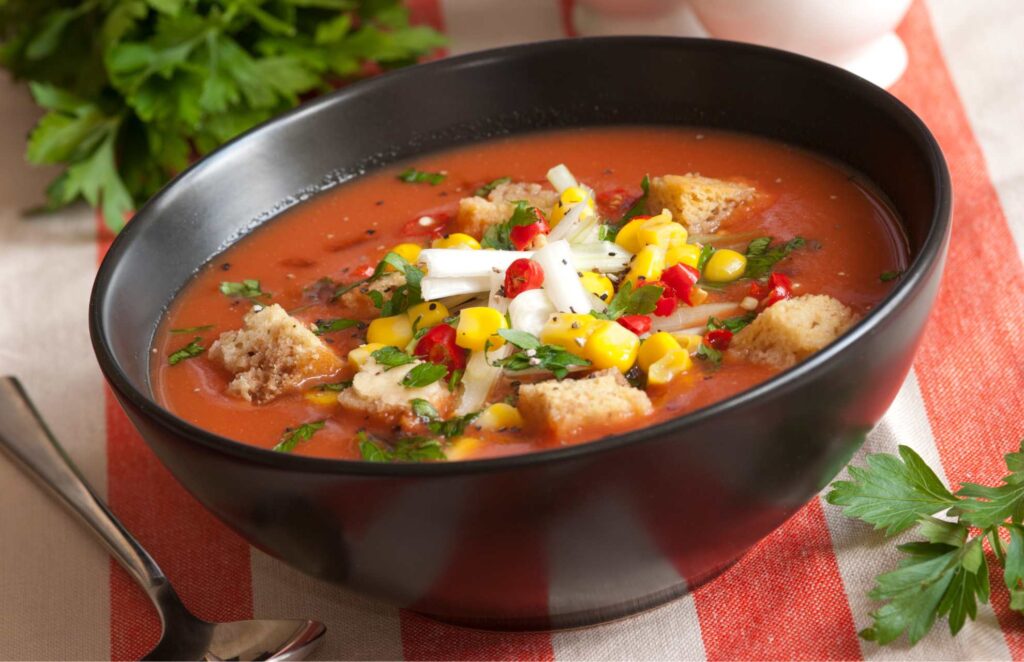
Where to try it:
- El Pimpi (Málaga): A cultural icon with traditional Andalusian fare.
- Bar Alfalfa (Seville): Cozy and casual, with excellent seasonal gazpacho.
- Bodegas Campos (Córdoba): Classic recipes in an elegant setting.
9. Jamón ibérico (Extremadura and Andalusia)
Made from black Iberian pigs raised on acorns and aged for up to four years, jamón iberico is Spain’s most prized dry cured ham. Silky, nutty, and deeply savory, it’s often hand-sliced and served in paper-thin ribbons — a ritual in itself. This iconic cured ham is a cornerstone of Spanish food, especially in the south and southwest.
There are several grades, with jamón ibérico de bellota at the top — a must if you’re serious about what to eat in Spain. It is best enjoyed on its own or with bread and features on cheese boards and upscale tapas.
Drinks pairing: A glass of tempranillo or fino sherry brings out the richness beautifully.
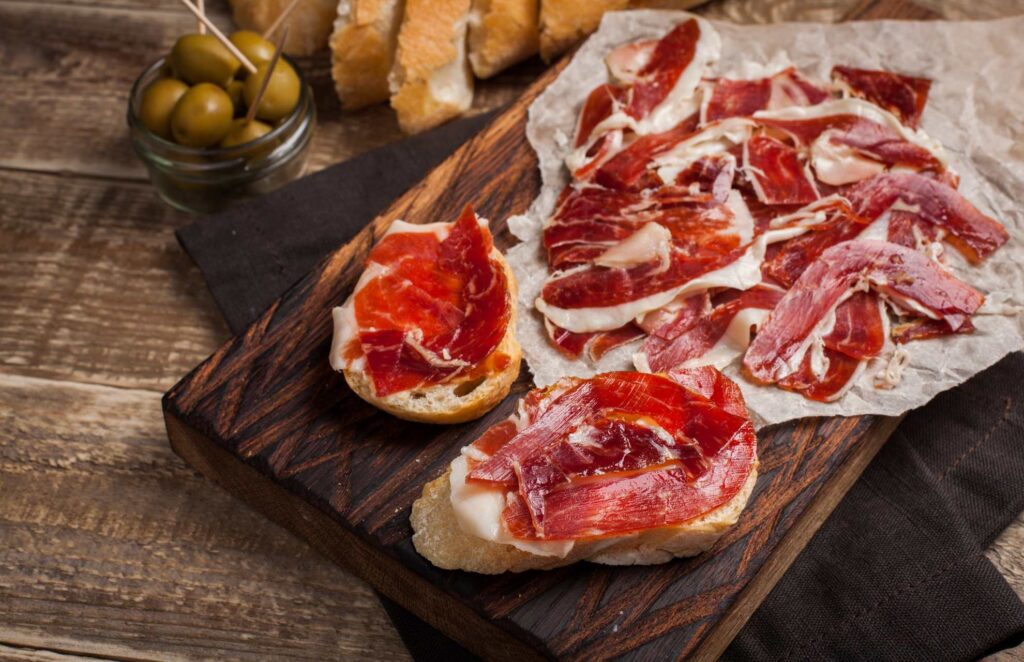
Where to try it:
- Enrique Tomás (Madrid and nationwide): A go-to chain specializing in Iberian hams of all grades.
- Reserva Ibérica (Barcelona): Offers tastings and expert carving in a sleek setting.
- Casa González (Madrid): A wine bar with a solid selection of cured meats and local wines.
Jamón is ubiquitous at weddings in Spain. During the cocktail hour, it is often served at a carving station (cortador de jamón). It’s a mark of status and quality — if the jamón is good, the wedding is off to a great start.
10. Manchego cheese (Castilla–La Mancha)
Speaking of cheese boards, manchego is the undisputed star. Made from sheep’s milk and aged anywhere from 60 days to two years, it’s firm, nutty, and slightly tangy — with a texture that ranges from creamy to crystalline depending on its age. It’s one of the most recognizable and beloved traditional foods in Spain, often paired with cured meats or quince paste (membrillo).
This cheese is deeply rooted in Spanish culture and often served as part of a main meal starter or in a classic tapas spread. Sharp enough to stand alone, it’s a favorite for locals and one of the best things to eat in Spain.
Drinks pairing: A glass of Rioja or a dry white from Rueda complements the cheese beautifully.
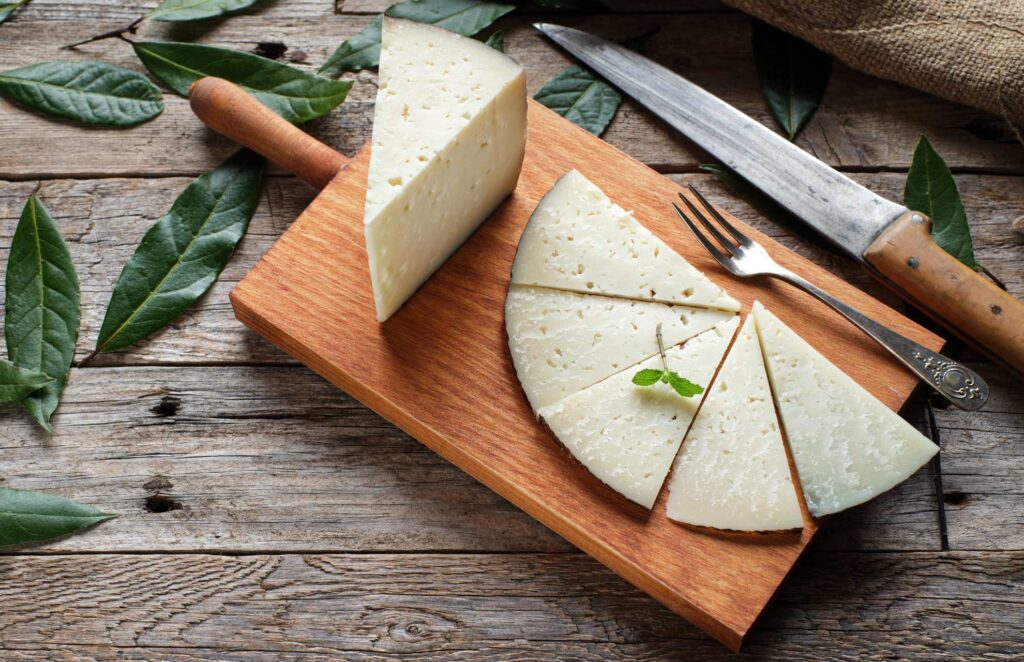
Where to try it:
- Mercado de San Miguel (Madrid): Visit the cheese stall for top-grade manchego by the slice.
- Poncelet Cheese Bar (Madrid): A full cheese restaurant offering curated boards and wine pairings.
- Lácteas García Baquero (Alcázar de San Juan): One of the most respected manchego producers, offering tours and tastings.
11. Pan con tomate (Catalonia)
Sometimes the simplest things say the most. Pan con tomate — toasted crusty bread rubbed with ripe tomato, garlic, and finished with a drizzle of olive oil — is a staple of everyday eating in Catalonia. Served on its own or alongside tapas, it’s a perfect example of how essential ingredients define Spanish culture at the table.
Though you’ll spot it on menus across the country, it’s a Catalan original. No tomato sauce, no fancy toppings — just good bread, fresh tomato, and a bit of salt. It’s one of those dishes you have to eat in Spain to fully appreciate.
Drinks pairing: Goes well with a local red or vermouth. For something lighter, try it with sparkling water and lemon — a common combo at lunch.
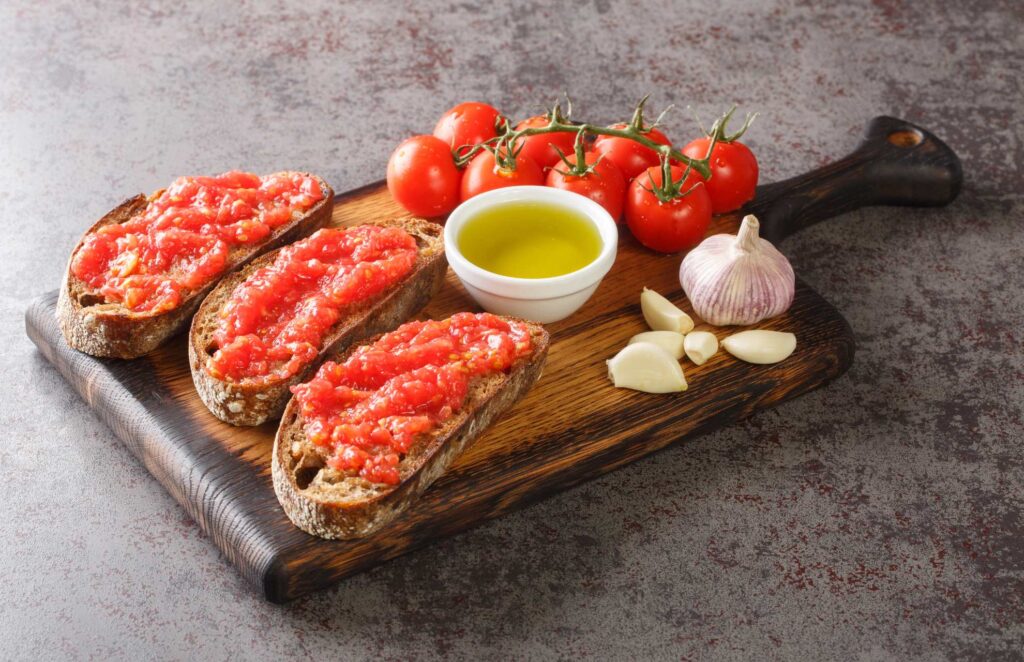
Where to try it:
- Bar del Pla (Barcelona): Cozy and unfussy, with a focus on high-quality ingredients.
- La Pepita (Barcelona): Modern tapas bar serving elevated classics.
- Can Culleretes (Barcelona): One of the city’s oldest restaurants — and still nailing the basics.
12. Escalivada (Catalonia)
A dish rooted in simplicity, escalivada is a mix of roasted vegetables — usually bell peppers, eggplant, and onions — peeled and served at room temperature, often drizzled with olive oil and accompanied by anchovies or tuna. It’s one of those local specialties that reflects the strength of Spanish cuisine: let quality ingredients speak for themselves.
Popular across Catalonia and parts of Aragon, it appears in many forms— served as tapas, on toast, or as a side for grilled meats. It’s also a smart choice for anyone looking to explore culinary delights beyond the usual suspects.
Drinks pairing: Try it with a Catalan white like Garnatxa Blanca, or even a light vermouth to bring out the smoky sweetness of the vegetables.
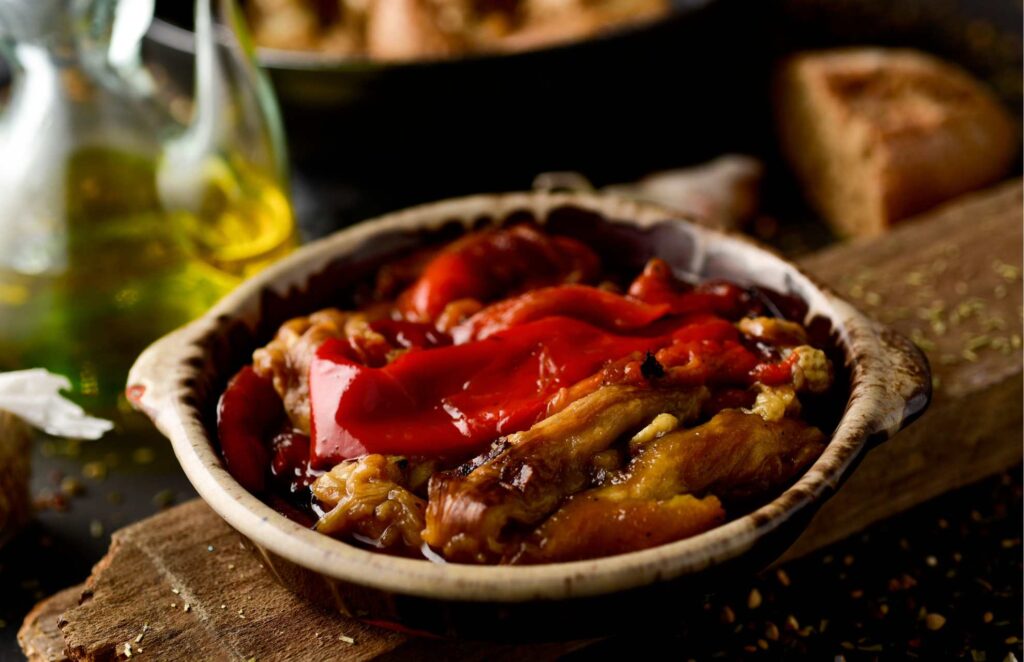
Where to try it:
- El Quim de la Boqueria (Barcelona): Market-fresh and always seasonal.
- Can Vilaró (Barcelona): Old-school Catalan cooking done right.
- Bar Cañete (Barcelona): A stylish, well-executed take on traditional plates.
13. Bacalao a la vizcaína (Basque Country)
Salted cod is among the most popular foods across Spain, but bacalao a la vizcaína — slow-cooked in a deep red pepper and tomato sauce — is a specialty of the Basque Country. It’s rich, savory, and tied closely to local Lenten traditions, though you’ll find it on menus year-round.
This dish, together with idiazabal cheese and cabrales cheese, shows off the Basque region’s love of bold, comforting flavors. Salted cod is one of the more quietly iconic items in northern Spanish cuisine, and it’s worth seeking out if you’re drawn to dishes with real character.
Drinks pairing: Best with a glass of young Rioja or txakoli, a lightly sparkling Basque white wine.
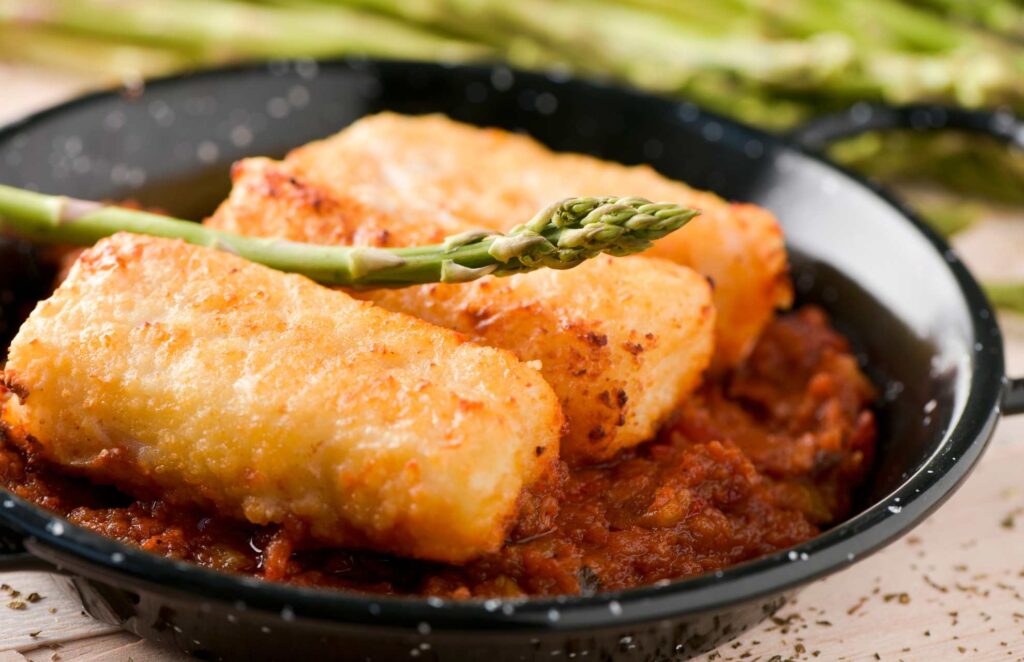
Where to try it:
- Café Iruña (Bilbao): Old-school charm with strong traditional offerings.
- Victor Montes (Bilbao): A historic tavern in the heart of the old town.
- Zortziko (Bilbao): Elegant setting with its own specialty takes on Basque classics.
Spaniards stew their salted cod for hours. The Dutch? They eat it raw with onions.Two very different takes on bold fish — and both worth trying. Here’s what’s on the plate in Amsterdam.
14. Pulpo a la gallega (Galicia)
A Galician classic, pulpo a la gallega is one of the most distinctive dishes from northern Spain. Tender octopus is sliced and served over boiled potatoes, sprinkled with coarse salt and smoked paprika, then drizzled with warm olive oil and sometimes lemon juice. It’s simple food, striking, and proudly represents Spain’s north coast.
This dish highlights Galicia’s deep connection to the sea and love for quality fresh seafood. This food is often served at local fairs and festivals on wooden plates — no frills, just flavor.
Drinks pairing: Traditionally paired with a glass of Galician white wine like Albariño or Ribeiro.
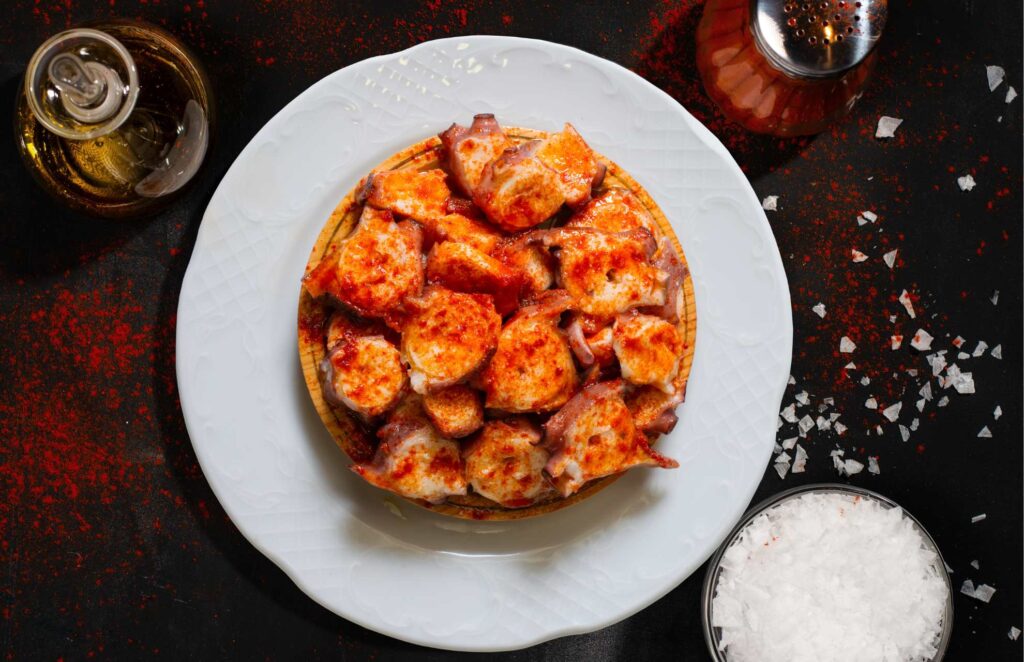
Where to try it:
- Pulpería A Garnacha (Ourense): Rustic and authentic, with regional wines.
- Casa Solla (Pontevedra): One of Spain’s oldest Michelin-starred restaurants.
- O Grove seafood market (O Grove): For a fresh, casual plate straight from the source.
15. Empanada gallega (Galicia)
Hearty and deeply rooted in tradition, empanada gallega is a savory pie filled with tuna, onion, and bell peppers, all folded into a thin, flaky pastry. Served warm or cold, it’s popular across Galicia as a snack, picnic staple, or part of a main meal.
Some versions swap the tuna for jamón serrano or local chorizo, giving the dish added depth. It’s one of those traditional foods in Spain that doesn’t always get international attention — but locals know it well.
Drinks pairing: Works well with a young red wine or a cold glass of beer, especially in summer.
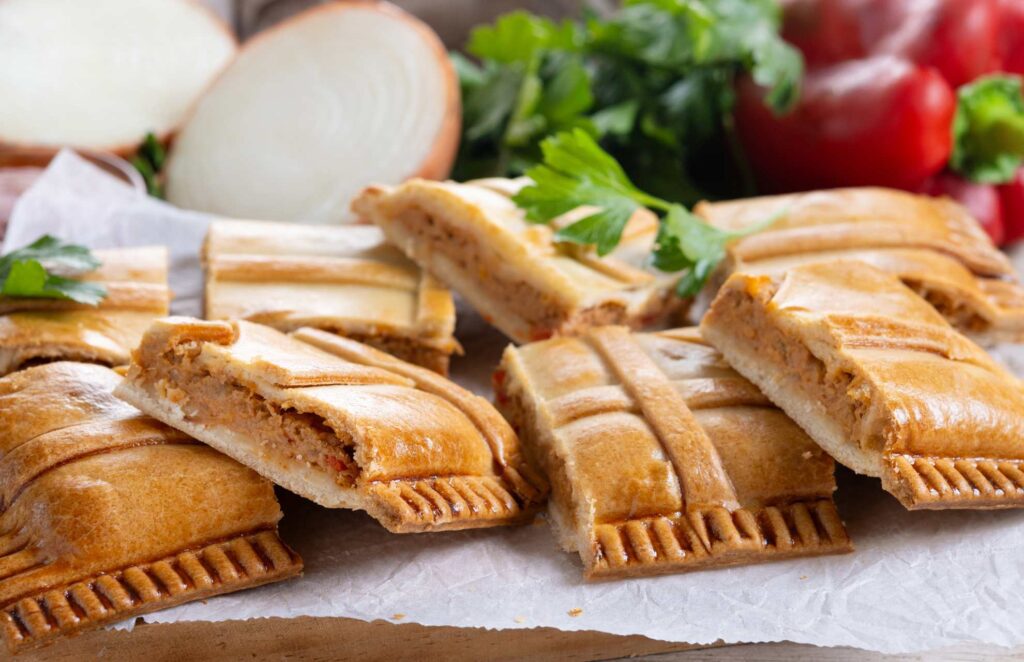
Where to try it:
- Mesón O Pote (Betanzos): Known for rustic, homemade empanadas.
- Panadería Divina Pastora (Santiago de Compostela): Beloved local bakery with rotating fillings.
- Pulpería Rial (La Coruña): Pairs their empanada with house pulpo and wine.
Regional guide to the best food in Spain
Spain’s culinary landscape is as diverse as its regions. While some Spanish dishes are found nationwide, many are rooted in local traditions, ingredients, and geography. Here’s a quick look at what to try — and where to find it — when you’re visiting Spain.
| Region | Dishes |
|---|---|
| Andalusia | Salmorejo, gazpacho |
| Madrid / Central Spain | Tortilla española, croquetas |
| Valencia | Paella de mariscos, fideuà |
| Catalonia | Pan con tomate, escalivada |
| Galicia (Northern Spain) | Pulpo a la gallega, empanada gallega |
| Basque Country (Northern Coast) | Bacalao a la vizcaína, plus cheeses like Idiazabal and Cabrales |
| Castilla–La Mancha | Manchego cheese, cured meats like jamón serrano |
| Extremadura | Jamón iberico, traditional dishes featuring white pigs |
Tips for navigating Spain and its food culture
Exploring Spain through its food isn’t just about tasting classic dishes — it’s about embracing a culture. Here are a few tips to help you get the most out of your culinary journey:
- Don’t rush your meals: Lunch is the main meal of the day, often between 2 and 4 PM, and dinner rarely starts before 9. Plan for long, relaxed meals — and don’t skip a popular dessert, especially if you want to eat like a local.
- In many bars, your drink comes with a bite to eat: In cities like Granada or León, the drink often includes a free tapa. It’s a great way to discover local specialties.
- Each region has its own food rules: Tortilla in Madrid isn’t the same as in San Sebastián — and neither are the sauces or seafood. Be curious, ask questions, and try the local version.
- Learn to love the late-night bite: From churros after midnight to full dinners at 10 PM, — eating late is part of the experience.
- Stay connected while you explore: From Michelin dining in San Sebastian to hidden neighborhood gems, a reliable internet connection makes it easier to look up hours, menus, and locations on Google Maps — especially when plans change on the go.
Getting one of the best eSIMs for Spain makes the most sense. It’s a far better option than relying on public WiFi, renting a portable hotspot, or swapping out SIM cards mid-trip. No physical cards, no waiting in line, and no roaming in Spain — just an easy way to stay connected while you eat your way across the country or join a spontaneous food tour.
Holafly’s eSIM for Spain gives you unlimited data from the moment you land. In just a couple of clicks, you can have an excellent connection throughout your stay.





 Language
Language 


















 No results found
No results found







